A Comprehensive Study on the Various Constructs of Childhood
VerifiedAdded on 2021/04/16
|12
|2400
|68
Report
AI Summary
This report, titled "Contemporary Perspectives of Learning and Development for Early Childhood," delves into various constructs of childhood, examining how children are perceived and understood. The assignment begins with an analysis of five images, each representing a different construct, such as the child as "innocent," the child as a "victim" (e.g., in the context of obesity), and the child as an "adult-in-training." The images are sourced from various contexts, including educational websites and magazines. The report then compares and contrasts these constructs, drawing on the works of Jean-Jacques Rousseau and other theorists to highlight the influence of adult perspectives on the construction of childhood. The assignment explores the roles of adults and the impact of social, political, and economic factors on how children are viewed. The report concludes by emphasizing the importance of proper guidance and support for children's development, acknowledging the sensitivity of this stage and the need for rationality in care and affection. The references include a range of scholarly articles and books that support the analysis of the constructs of childhood.
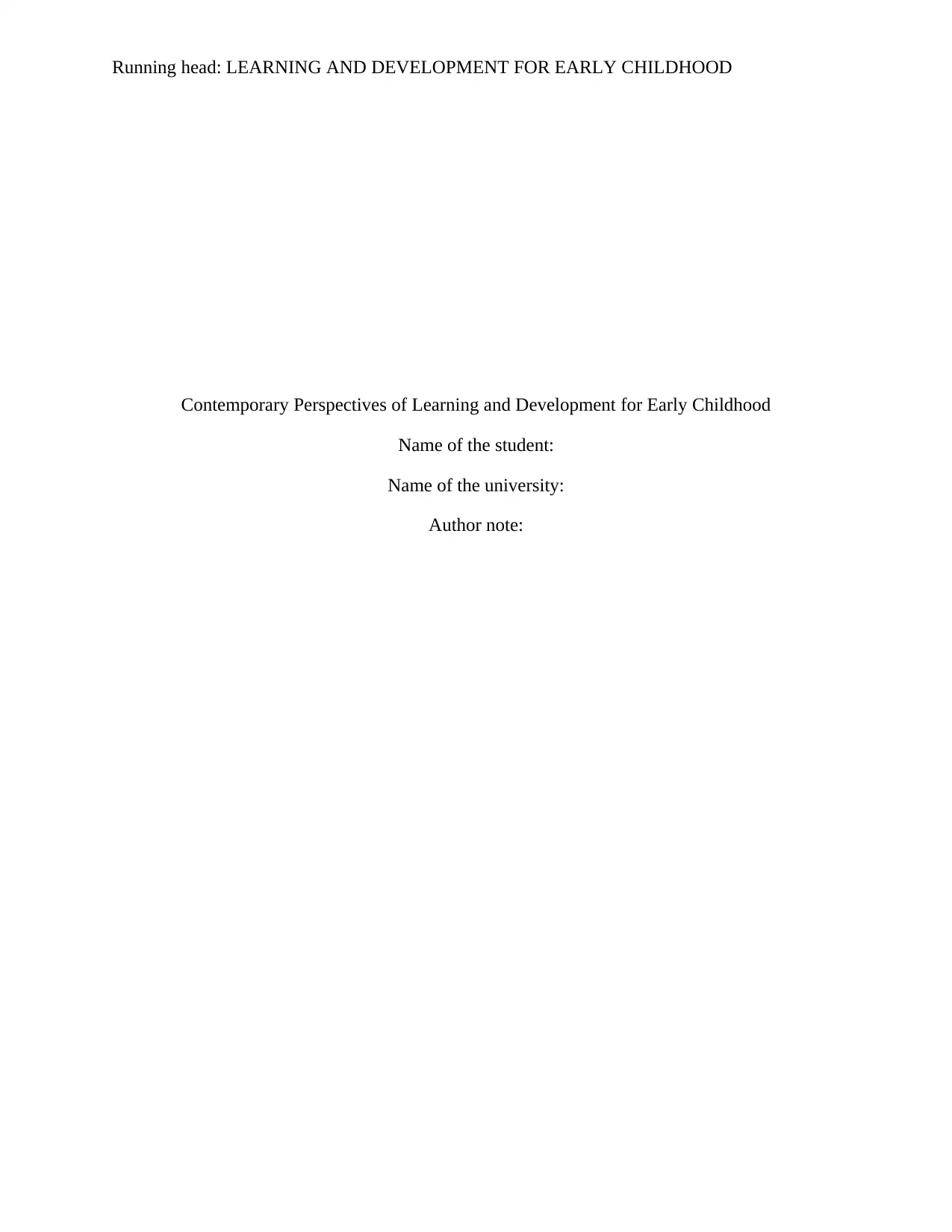
Running head: LEARNING AND DEVELOPMENT FOR EARLY CHILDHOOD
Contemporary Perspectives of Learning and Development for Early Childhood
Name of the student:
Name of the university:
Author note:
Contemporary Perspectives of Learning and Development for Early Childhood
Name of the student:
Name of the university:
Author note:
Paraphrase This Document
Need a fresh take? Get an instant paraphrase of this document with our AI Paraphraser
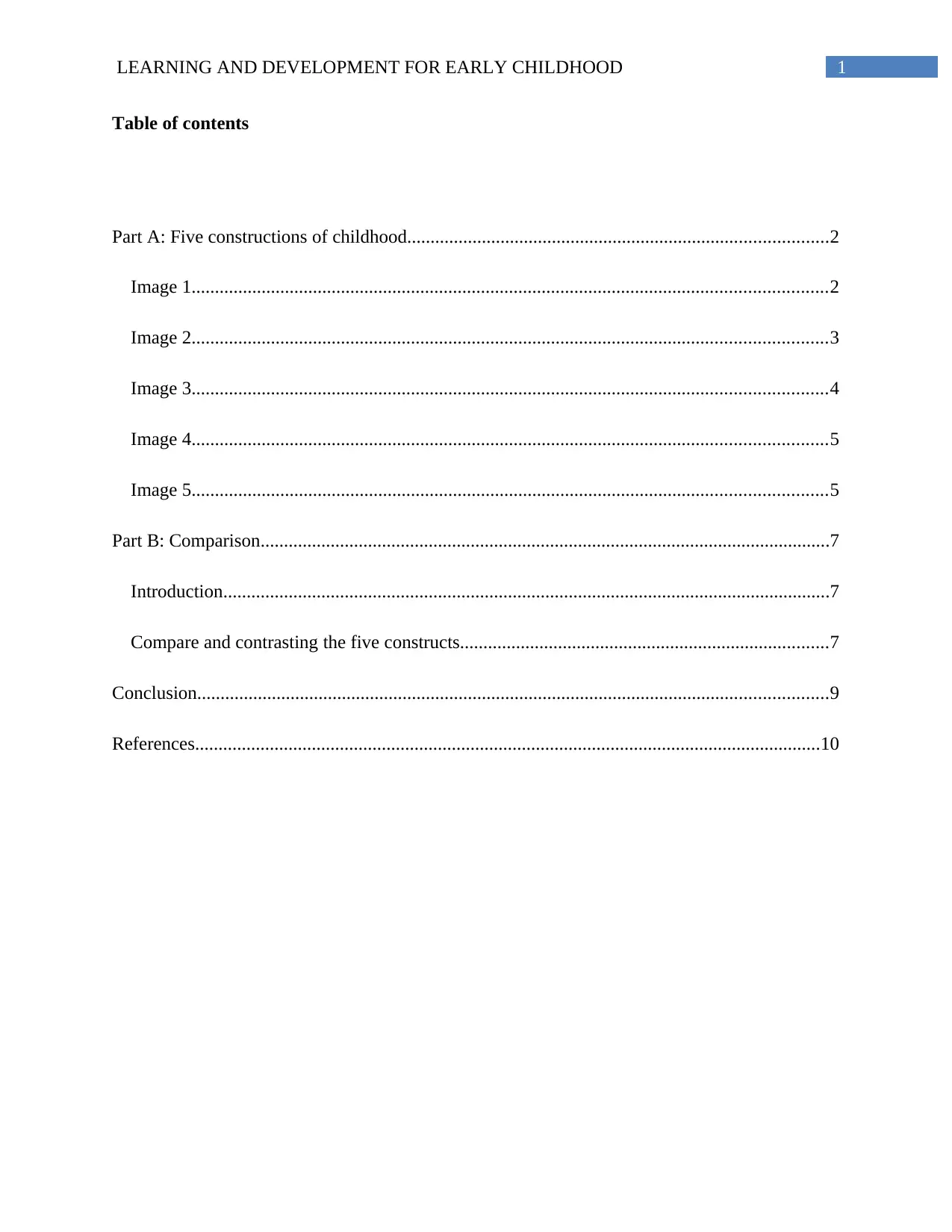
1LEARNING AND DEVELOPMENT FOR EARLY CHILDHOOD
Table of contents
Part A: Five constructions of childhood..........................................................................................2
Image 1........................................................................................................................................2
Image 2........................................................................................................................................3
Image 3........................................................................................................................................4
Image 4........................................................................................................................................5
Image 5........................................................................................................................................5
Part B: Comparison..........................................................................................................................7
Introduction..................................................................................................................................7
Compare and contrasting the five constructs...............................................................................7
Conclusion.......................................................................................................................................9
References......................................................................................................................................10
Table of contents
Part A: Five constructions of childhood..........................................................................................2
Image 1........................................................................................................................................2
Image 2........................................................................................................................................3
Image 3........................................................................................................................................4
Image 4........................................................................................................................................5
Image 5........................................................................................................................................5
Part B: Comparison..........................................................................................................................7
Introduction..................................................................................................................................7
Compare and contrasting the five constructs...............................................................................7
Conclusion.......................................................................................................................................9
References......................................................................................................................................10
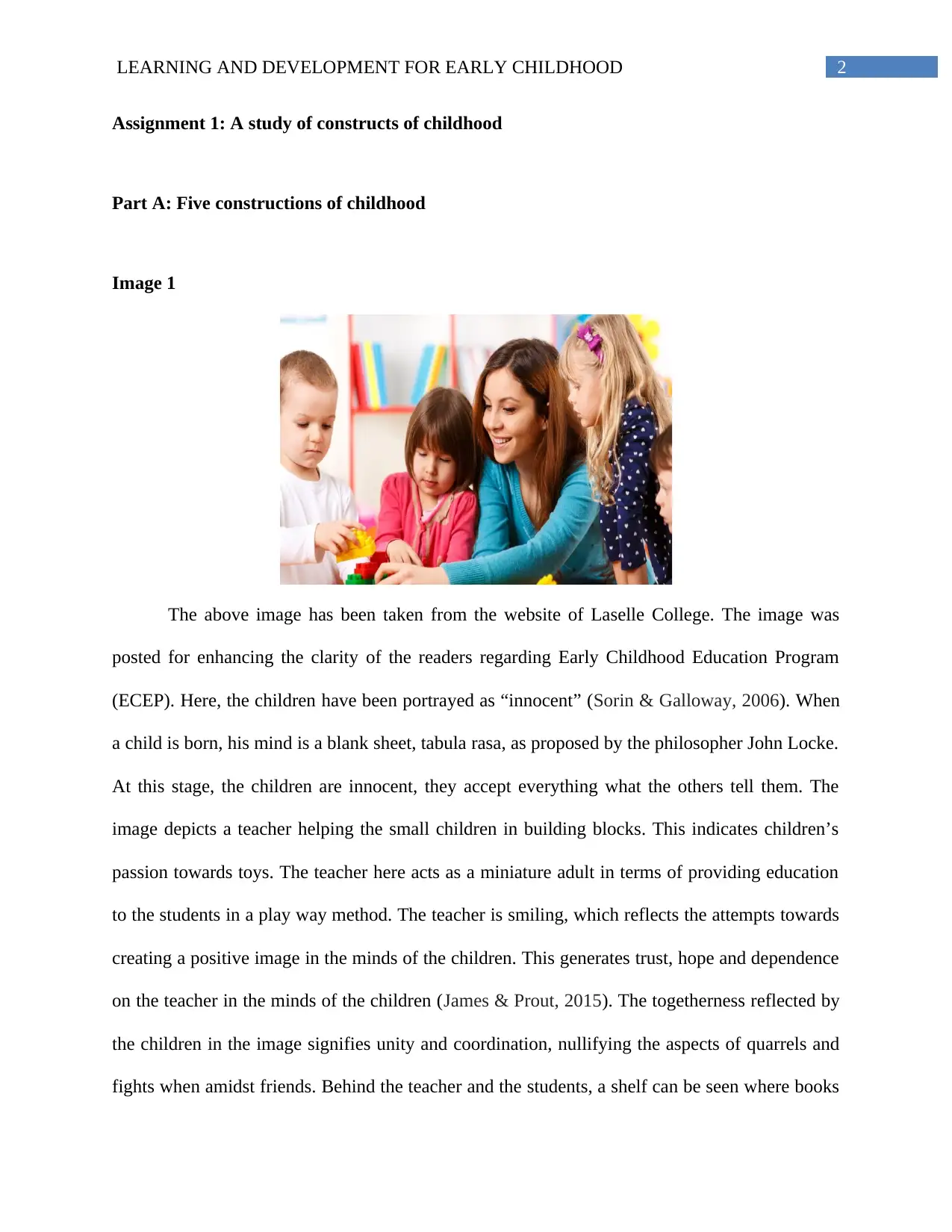
2LEARNING AND DEVELOPMENT FOR EARLY CHILDHOOD
Assignment 1: A study of constructs of childhood
Part A: Five constructions of childhood
Image 1
The above image has been taken from the website of Laselle College. The image was
posted for enhancing the clarity of the readers regarding Early Childhood Education Program
(ECEP). Here, the children have been portrayed as “innocent” (Sorin & Galloway, 2006). When
a child is born, his mind is a blank sheet, tabula rasa, as proposed by the philosopher John Locke.
At this stage, the children are innocent, they accept everything what the others tell them. The
image depicts a teacher helping the small children in building blocks. This indicates children’s
passion towards toys. The teacher here acts as a miniature adult in terms of providing education
to the students in a play way method. The teacher is smiling, which reflects the attempts towards
creating a positive image in the minds of the children. This generates trust, hope and dependence
on the teacher in the minds of the children (James & Prout, 2015). The togetherness reflected by
the children in the image signifies unity and coordination, nullifying the aspects of quarrels and
fights when amidst friends. Behind the teacher and the students, a shelf can be seen where books
Assignment 1: A study of constructs of childhood
Part A: Five constructions of childhood
Image 1
The above image has been taken from the website of Laselle College. The image was
posted for enhancing the clarity of the readers regarding Early Childhood Education Program
(ECEP). Here, the children have been portrayed as “innocent” (Sorin & Galloway, 2006). When
a child is born, his mind is a blank sheet, tabula rasa, as proposed by the philosopher John Locke.
At this stage, the children are innocent, they accept everything what the others tell them. The
image depicts a teacher helping the small children in building blocks. This indicates children’s
passion towards toys. The teacher here acts as a miniature adult in terms of providing education
to the students in a play way method. The teacher is smiling, which reflects the attempts towards
creating a positive image in the minds of the children. This generates trust, hope and dependence
on the teacher in the minds of the children (James & Prout, 2015). The togetherness reflected by
the children in the image signifies unity and coordination, nullifying the aspects of quarrels and
fights when amidst friends. Behind the teacher and the students, a shelf can be seen where books
⊘ This is a preview!⊘
Do you want full access?
Subscribe today to unlock all pages.

Trusted by 1+ million students worldwide
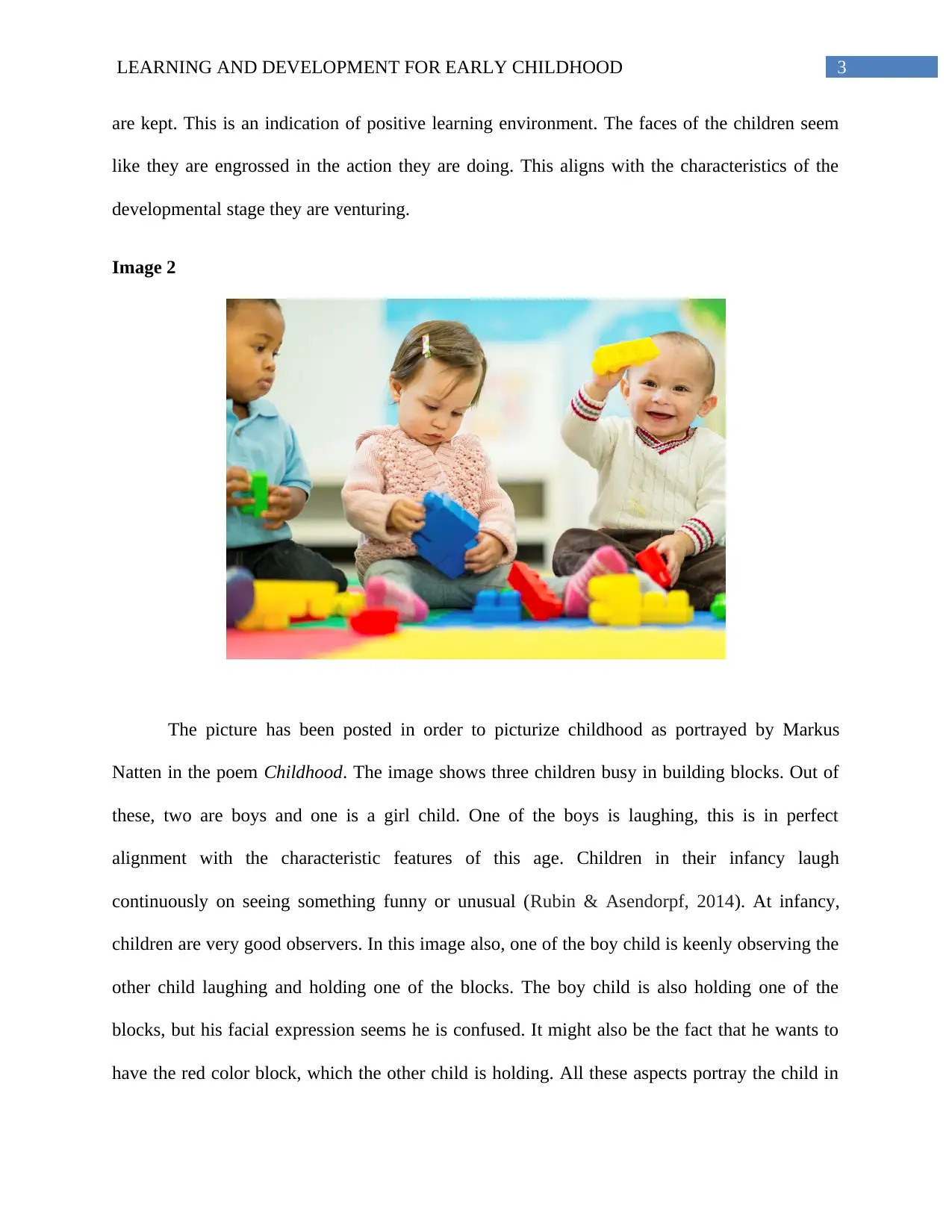
3LEARNING AND DEVELOPMENT FOR EARLY CHILDHOOD
are kept. This is an indication of positive learning environment. The faces of the children seem
like they are engrossed in the action they are doing. This aligns with the characteristics of the
developmental stage they are venturing.
Image 2
The picture has been posted in order to picturize childhood as portrayed by Markus
Natten in the poem Childhood. The image shows three children busy in building blocks. Out of
these, two are boys and one is a girl child. One of the boys is laughing, this is in perfect
alignment with the characteristic features of this age. Children in their infancy laugh
continuously on seeing something funny or unusual (Rubin & Asendorpf, 2014). At infancy,
children are very good observers. In this image also, one of the boy child is keenly observing the
other child laughing and holding one of the blocks. The boy child is also holding one of the
blocks, but his facial expression seems he is confused. It might also be the fact that he wants to
have the red color block, which the other child is holding. All these aspects portray the child in
are kept. This is an indication of positive learning environment. The faces of the children seem
like they are engrossed in the action they are doing. This aligns with the characteristics of the
developmental stage they are venturing.
Image 2
The picture has been posted in order to picturize childhood as portrayed by Markus
Natten in the poem Childhood. The image shows three children busy in building blocks. Out of
these, two are boys and one is a girl child. One of the boys is laughing, this is in perfect
alignment with the characteristic features of this age. Children in their infancy laugh
continuously on seeing something funny or unusual (Rubin & Asendorpf, 2014). At infancy,
children are very good observers. In this image also, one of the boy child is keenly observing the
other child laughing and holding one of the blocks. The boy child is also holding one of the
blocks, but his facial expression seems he is confused. It might also be the fact that he wants to
have the red color block, which the other child is holding. All these aspects portray the child in
Paraphrase This Document
Need a fresh take? Get an instant paraphrase of this document with our AI Paraphraser
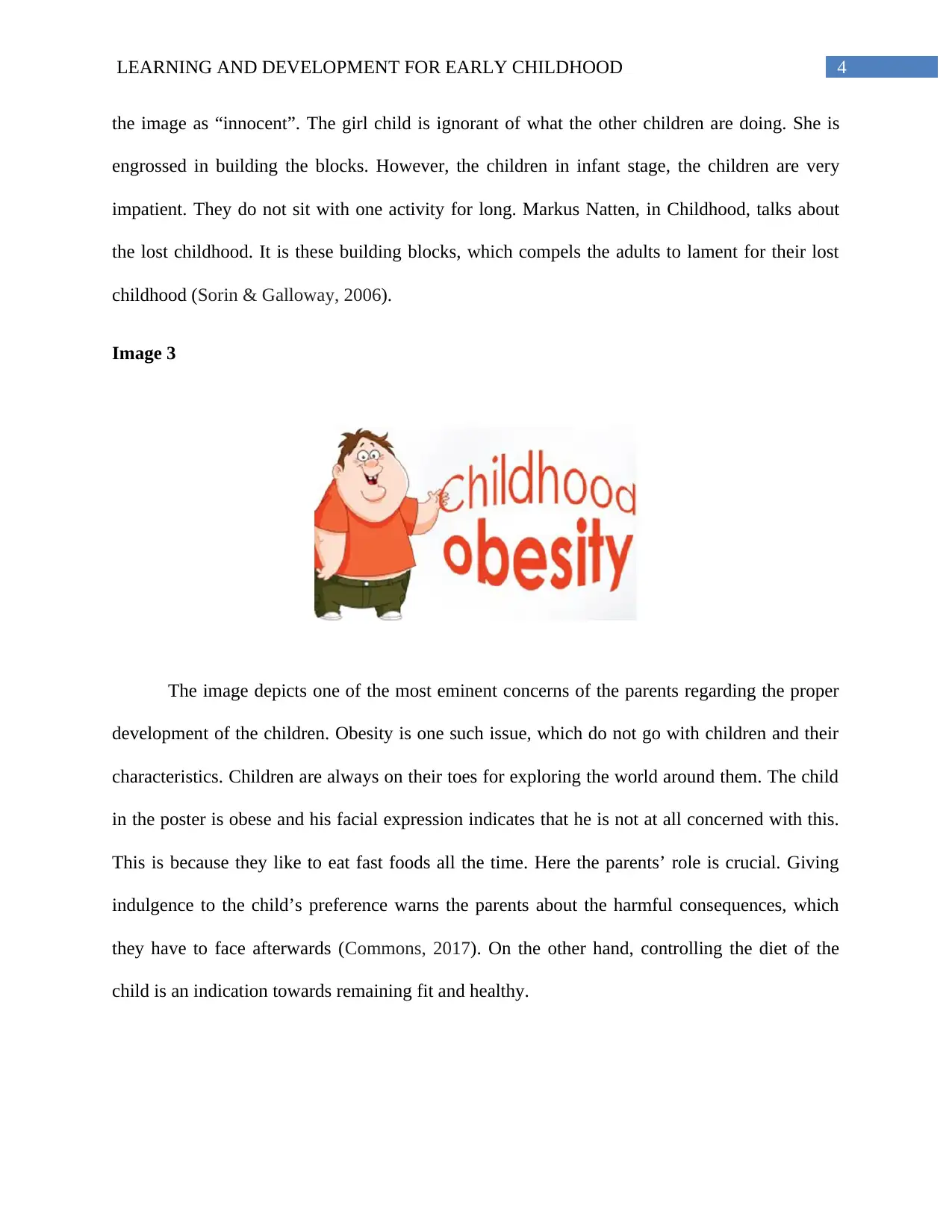
4LEARNING AND DEVELOPMENT FOR EARLY CHILDHOOD
the image as “innocent”. The girl child is ignorant of what the other children are doing. She is
engrossed in building the blocks. However, the children in infant stage, the children are very
impatient. They do not sit with one activity for long. Markus Natten, in Childhood, talks about
the lost childhood. It is these building blocks, which compels the adults to lament for their lost
childhood (Sorin & Galloway, 2006).
Image 3
The image depicts one of the most eminent concerns of the parents regarding the proper
development of the children. Obesity is one such issue, which do not go with children and their
characteristics. Children are always on their toes for exploring the world around them. The child
in the poster is obese and his facial expression indicates that he is not at all concerned with this.
This is because they like to eat fast foods all the time. Here the parents’ role is crucial. Giving
indulgence to the child’s preference warns the parents about the harmful consequences, which
they have to face afterwards (Commons, 2017). On the other hand, controlling the diet of the
child is an indication towards remaining fit and healthy.
the image as “innocent”. The girl child is ignorant of what the other children are doing. She is
engrossed in building the blocks. However, the children in infant stage, the children are very
impatient. They do not sit with one activity for long. Markus Natten, in Childhood, talks about
the lost childhood. It is these building blocks, which compels the adults to lament for their lost
childhood (Sorin & Galloway, 2006).
Image 3
The image depicts one of the most eminent concerns of the parents regarding the proper
development of the children. Obesity is one such issue, which do not go with children and their
characteristics. Children are always on their toes for exploring the world around them. The child
in the poster is obese and his facial expression indicates that he is not at all concerned with this.
This is because they like to eat fast foods all the time. Here the parents’ role is crucial. Giving
indulgence to the child’s preference warns the parents about the harmful consequences, which
they have to face afterwards (Commons, 2017). On the other hand, controlling the diet of the
child is an indication towards remaining fit and healthy.
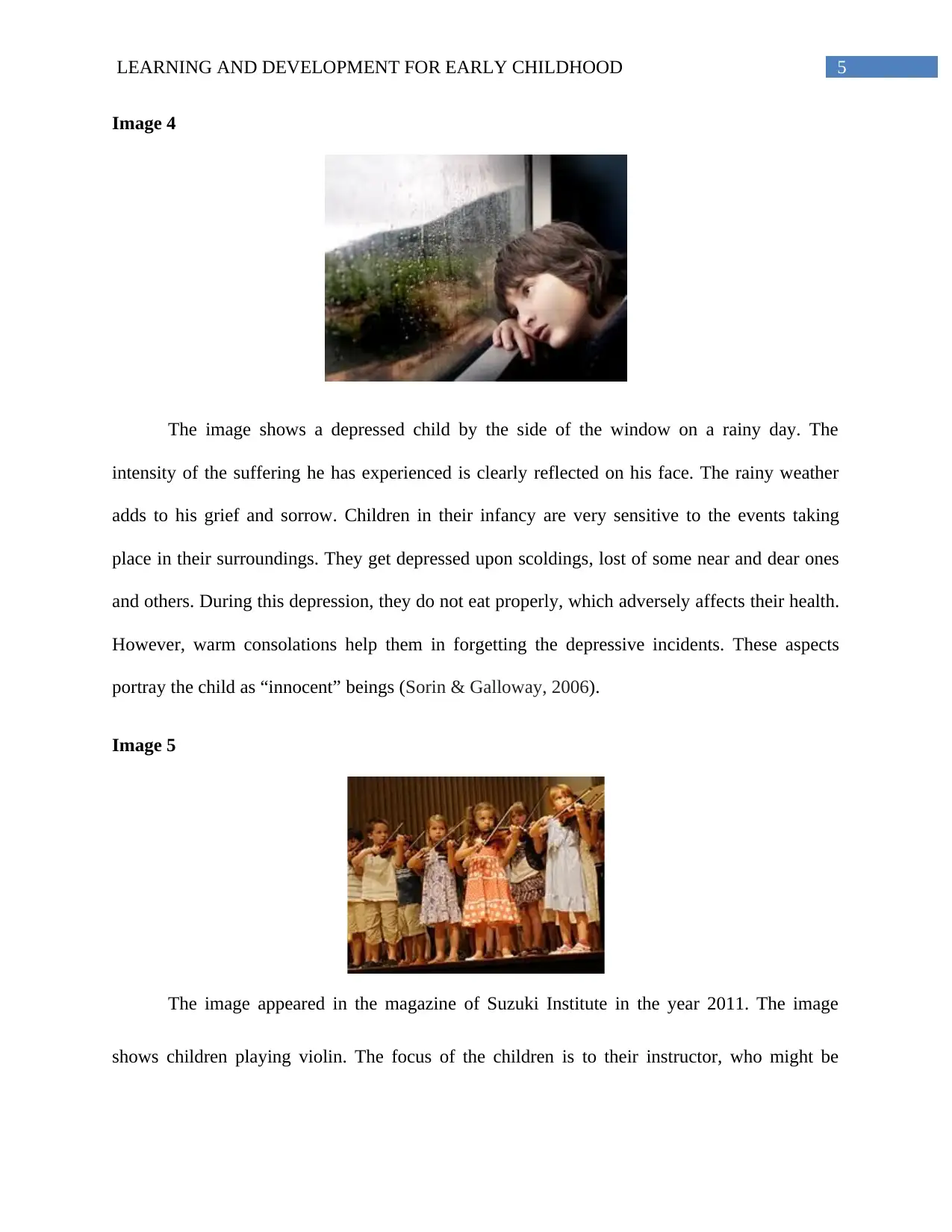
5LEARNING AND DEVELOPMENT FOR EARLY CHILDHOOD
Image 4
The image shows a depressed child by the side of the window on a rainy day. The
intensity of the suffering he has experienced is clearly reflected on his face. The rainy weather
adds to his grief and sorrow. Children in their infancy are very sensitive to the events taking
place in their surroundings. They get depressed upon scoldings, lost of some near and dear ones
and others. During this depression, they do not eat properly, which adversely affects their health.
However, warm consolations help them in forgetting the depressive incidents. These aspects
portray the child as “innocent” beings (Sorin & Galloway, 2006).
Image 5
The image appeared in the magazine of Suzuki Institute in the year 2011. The image
shows children playing violin. The focus of the children is to their instructor, who might be
Image 4
The image shows a depressed child by the side of the window on a rainy day. The
intensity of the suffering he has experienced is clearly reflected on his face. The rainy weather
adds to his grief and sorrow. Children in their infancy are very sensitive to the events taking
place in their surroundings. They get depressed upon scoldings, lost of some near and dear ones
and others. During this depression, they do not eat properly, which adversely affects their health.
However, warm consolations help them in forgetting the depressive incidents. These aspects
portray the child as “innocent” beings (Sorin & Galloway, 2006).
Image 5
The image appeared in the magazine of Suzuki Institute in the year 2011. The image
shows children playing violin. The focus of the children is to their instructor, who might be
⊘ This is a preview!⊘
Do you want full access?
Subscribe today to unlock all pages.

Trusted by 1+ million students worldwide
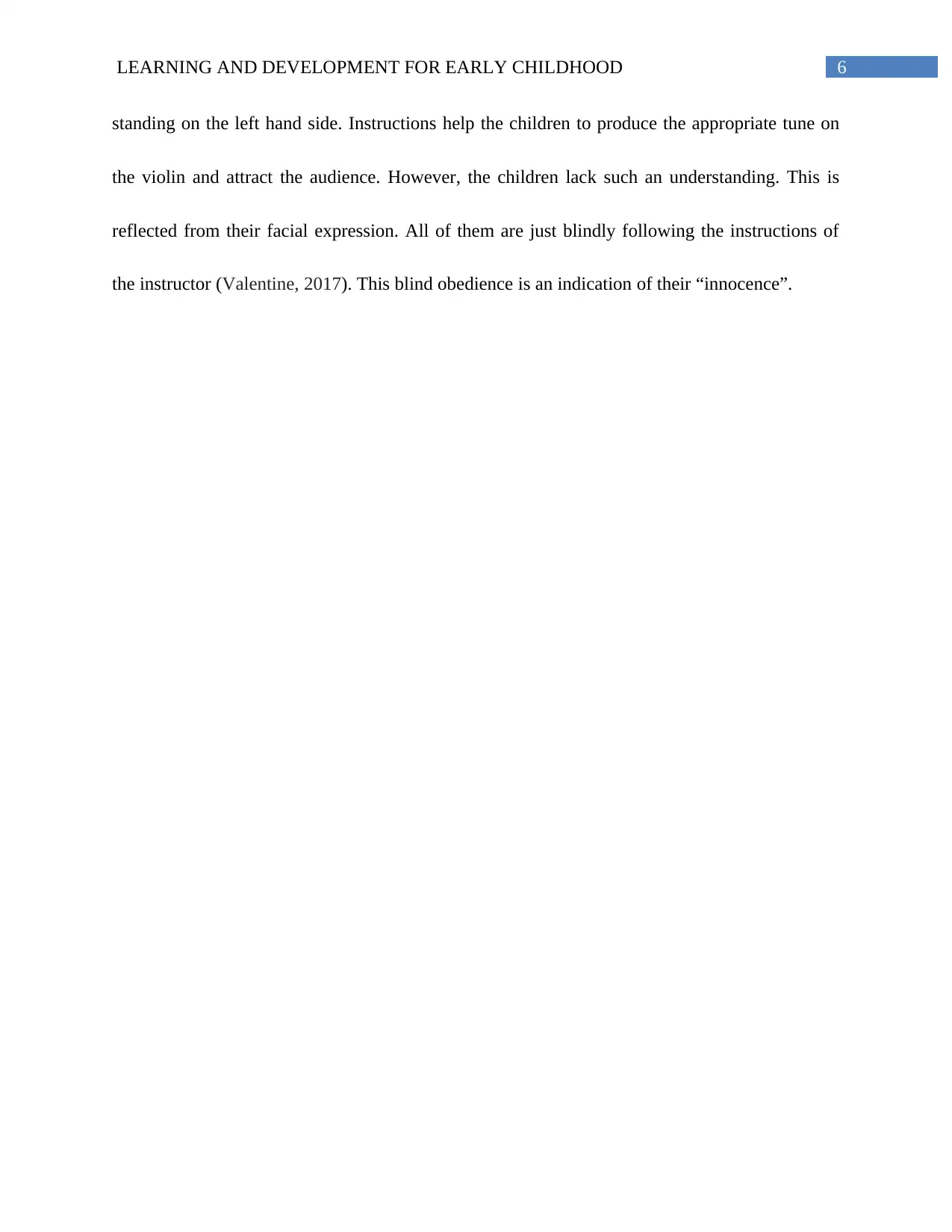
6LEARNING AND DEVELOPMENT FOR EARLY CHILDHOOD
standing on the left hand side. Instructions help the children to produce the appropriate tune on
the violin and attract the audience. However, the children lack such an understanding. This is
reflected from their facial expression. All of them are just blindly following the instructions of
the instructor (Valentine, 2017). This blind obedience is an indication of their “innocence”.
standing on the left hand side. Instructions help the children to produce the appropriate tune on
the violin and attract the audience. However, the children lack such an understanding. This is
reflected from their facial expression. All of them are just blindly following the instructions of
the instructor (Valentine, 2017). This blind obedience is an indication of their “innocence”.
Paraphrase This Document
Need a fresh take? Get an instant paraphrase of this document with our AI Paraphraser
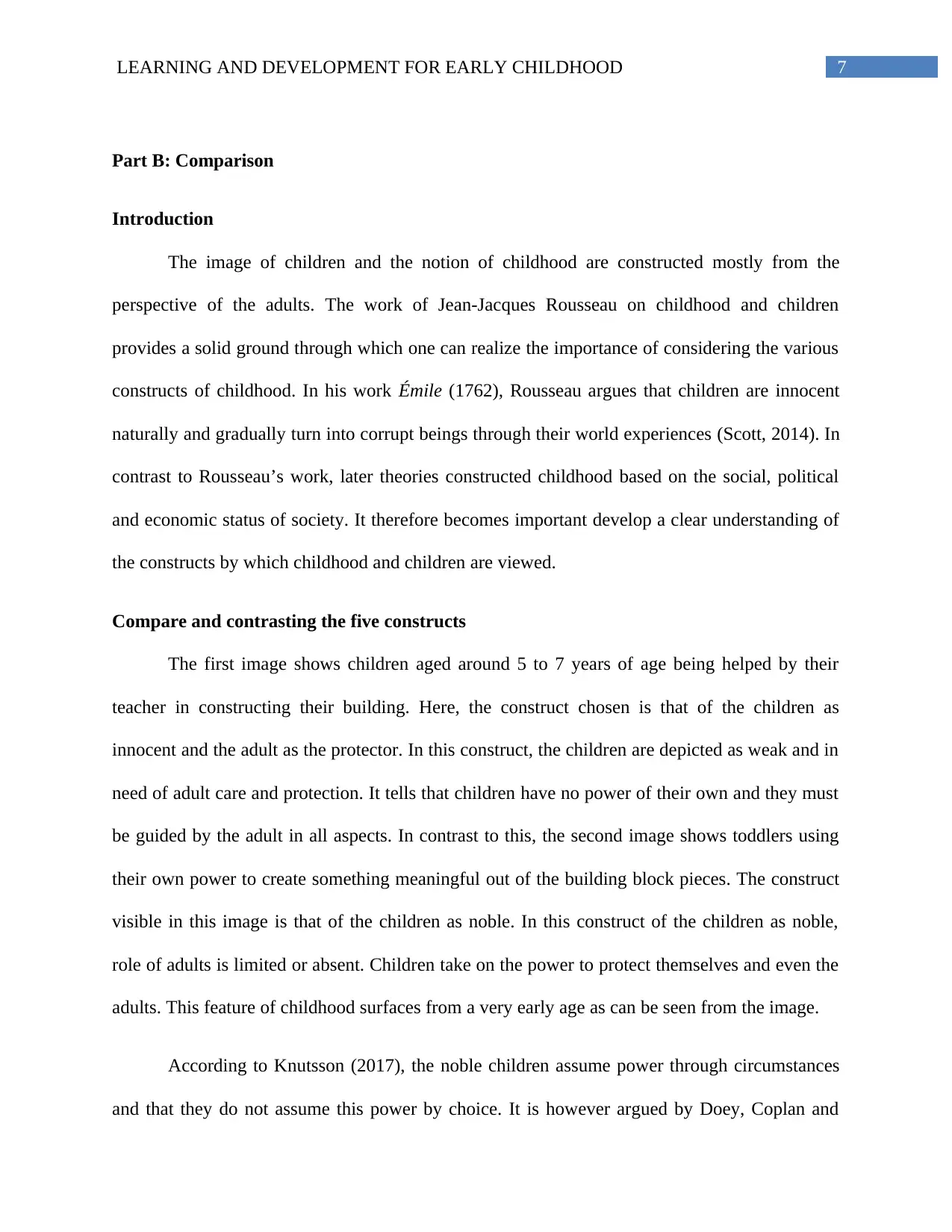
7LEARNING AND DEVELOPMENT FOR EARLY CHILDHOOD
Part B: Comparison
Introduction
The image of children and the notion of childhood are constructed mostly from the
perspective of the adults. The work of Jean-Jacques Rousseau on childhood and children
provides a solid ground through which one can realize the importance of considering the various
constructs of childhood. In his work Émile (1762), Rousseau argues that children are innocent
naturally and gradually turn into corrupt beings through their world experiences (Scott, 2014). In
contrast to Rousseau’s work, later theories constructed childhood based on the social, political
and economic status of society. It therefore becomes important develop a clear understanding of
the constructs by which childhood and children are viewed.
Compare and contrasting the five constructs
The first image shows children aged around 5 to 7 years of age being helped by their
teacher in constructing their building. Here, the construct chosen is that of the children as
innocent and the adult as the protector. In this construct, the children are depicted as weak and in
need of adult care and protection. It tells that children have no power of their own and they must
be guided by the adult in all aspects. In contrast to this, the second image shows toddlers using
their own power to create something meaningful out of the building block pieces. The construct
visible in this image is that of the children as noble. In this construct of the children as noble,
role of adults is limited or absent. Children take on the power to protect themselves and even the
adults. This feature of childhood surfaces from a very early age as can be seen from the image.
According to Knutsson (2017), the noble children assume power through circumstances
and that they do not assume this power by choice. It is however argued by Doey, Coplan and
Part B: Comparison
Introduction
The image of children and the notion of childhood are constructed mostly from the
perspective of the adults. The work of Jean-Jacques Rousseau on childhood and children
provides a solid ground through which one can realize the importance of considering the various
constructs of childhood. In his work Émile (1762), Rousseau argues that children are innocent
naturally and gradually turn into corrupt beings through their world experiences (Scott, 2014). In
contrast to Rousseau’s work, later theories constructed childhood based on the social, political
and economic status of society. It therefore becomes important develop a clear understanding of
the constructs by which childhood and children are viewed.
Compare and contrasting the five constructs
The first image shows children aged around 5 to 7 years of age being helped by their
teacher in constructing their building. Here, the construct chosen is that of the children as
innocent and the adult as the protector. In this construct, the children are depicted as weak and in
need of adult care and protection. It tells that children have no power of their own and they must
be guided by the adult in all aspects. In contrast to this, the second image shows toddlers using
their own power to create something meaningful out of the building block pieces. The construct
visible in this image is that of the children as noble. In this construct of the children as noble,
role of adults is limited or absent. Children take on the power to protect themselves and even the
adults. This feature of childhood surfaces from a very early age as can be seen from the image.
According to Knutsson (2017), the noble children assume power through circumstances
and that they do not assume this power by choice. It is however argued by Doey, Coplan and
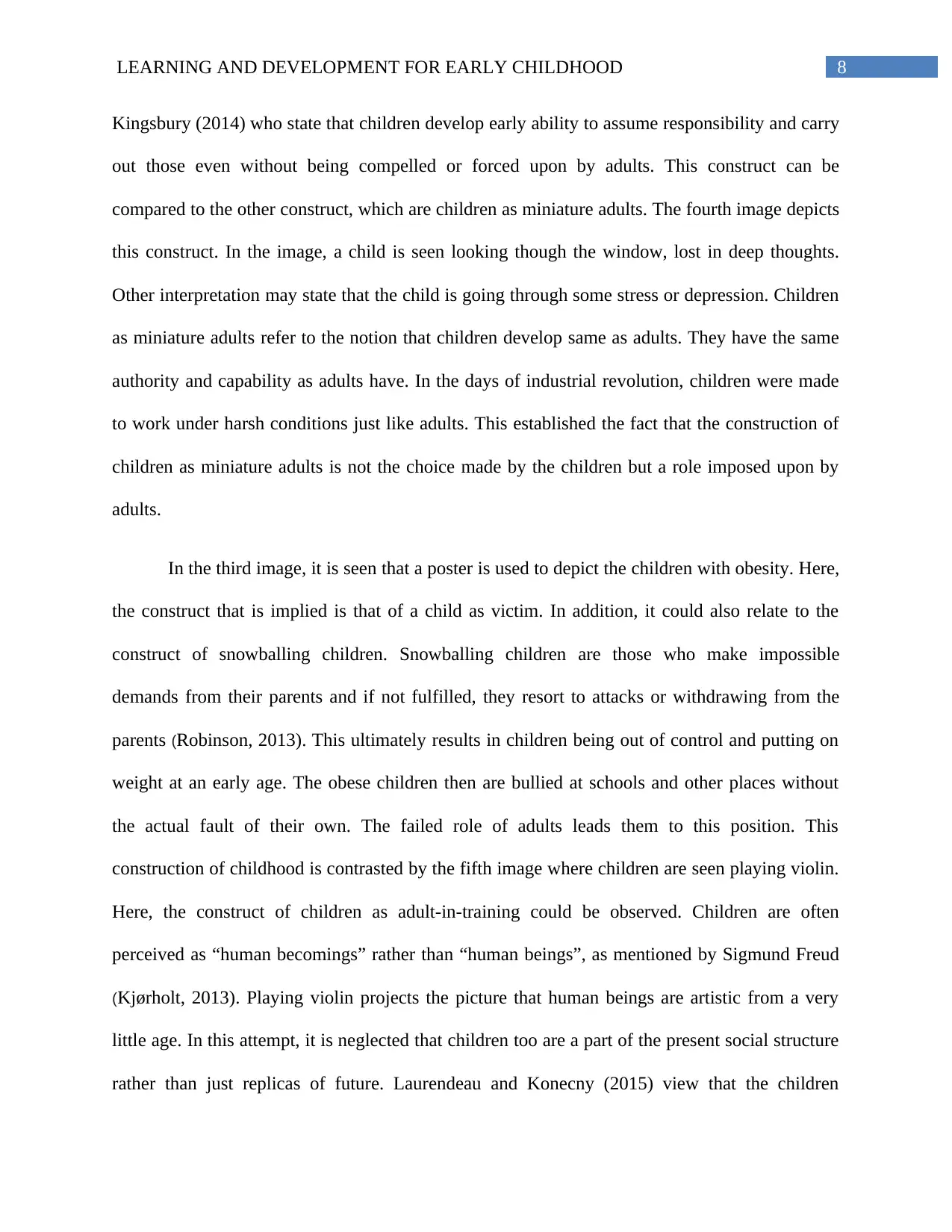
8LEARNING AND DEVELOPMENT FOR EARLY CHILDHOOD
Kingsbury (2014) who state that children develop early ability to assume responsibility and carry
out those even without being compelled or forced upon by adults. This construct can be
compared to the other construct, which are children as miniature adults. The fourth image depicts
this construct. In the image, a child is seen looking though the window, lost in deep thoughts.
Other interpretation may state that the child is going through some stress or depression. Children
as miniature adults refer to the notion that children develop same as adults. They have the same
authority and capability as adults have. In the days of industrial revolution, children were made
to work under harsh conditions just like adults. This established the fact that the construction of
children as miniature adults is not the choice made by the children but a role imposed upon by
adults.
In the third image, it is seen that a poster is used to depict the children with obesity. Here,
the construct that is implied is that of a child as victim. In addition, it could also relate to the
construct of snowballing children. Snowballing children are those who make impossible
demands from their parents and if not fulfilled, they resort to attacks or withdrawing from the
parents (Robinson, 2013). This ultimately results in children being out of control and putting on
weight at an early age. The obese children then are bullied at schools and other places without
the actual fault of their own. The failed role of adults leads them to this position. This
construction of childhood is contrasted by the fifth image where children are seen playing violin.
Here, the construct of children as adult-in-training could be observed. Children are often
perceived as “human becomings” rather than “human beings”, as mentioned by Sigmund Freud
(Kjørholt, 2013). Playing violin projects the picture that human beings are artistic from a very
little age. In this attempt, it is neglected that children too are a part of the present social structure
rather than just replicas of future. Laurendeau and Konecny (2015) view that the children
Kingsbury (2014) who state that children develop early ability to assume responsibility and carry
out those even without being compelled or forced upon by adults. This construct can be
compared to the other construct, which are children as miniature adults. The fourth image depicts
this construct. In the image, a child is seen looking though the window, lost in deep thoughts.
Other interpretation may state that the child is going through some stress or depression. Children
as miniature adults refer to the notion that children develop same as adults. They have the same
authority and capability as adults have. In the days of industrial revolution, children were made
to work under harsh conditions just like adults. This established the fact that the construction of
children as miniature adults is not the choice made by the children but a role imposed upon by
adults.
In the third image, it is seen that a poster is used to depict the children with obesity. Here,
the construct that is implied is that of a child as victim. In addition, it could also relate to the
construct of snowballing children. Snowballing children are those who make impossible
demands from their parents and if not fulfilled, they resort to attacks or withdrawing from the
parents (Robinson, 2013). This ultimately results in children being out of control and putting on
weight at an early age. The obese children then are bullied at schools and other places without
the actual fault of their own. The failed role of adults leads them to this position. This
construction of childhood is contrasted by the fifth image where children are seen playing violin.
Here, the construct of children as adult-in-training could be observed. Children are often
perceived as “human becomings” rather than “human beings”, as mentioned by Sigmund Freud
(Kjørholt, 2013). Playing violin projects the picture that human beings are artistic from a very
little age. In this attempt, it is neglected that children too are a part of the present social structure
rather than just replicas of future. Laurendeau and Konecny (2015) view that the children
⊘ This is a preview!⊘
Do you want full access?
Subscribe today to unlock all pages.

Trusted by 1+ million students worldwide
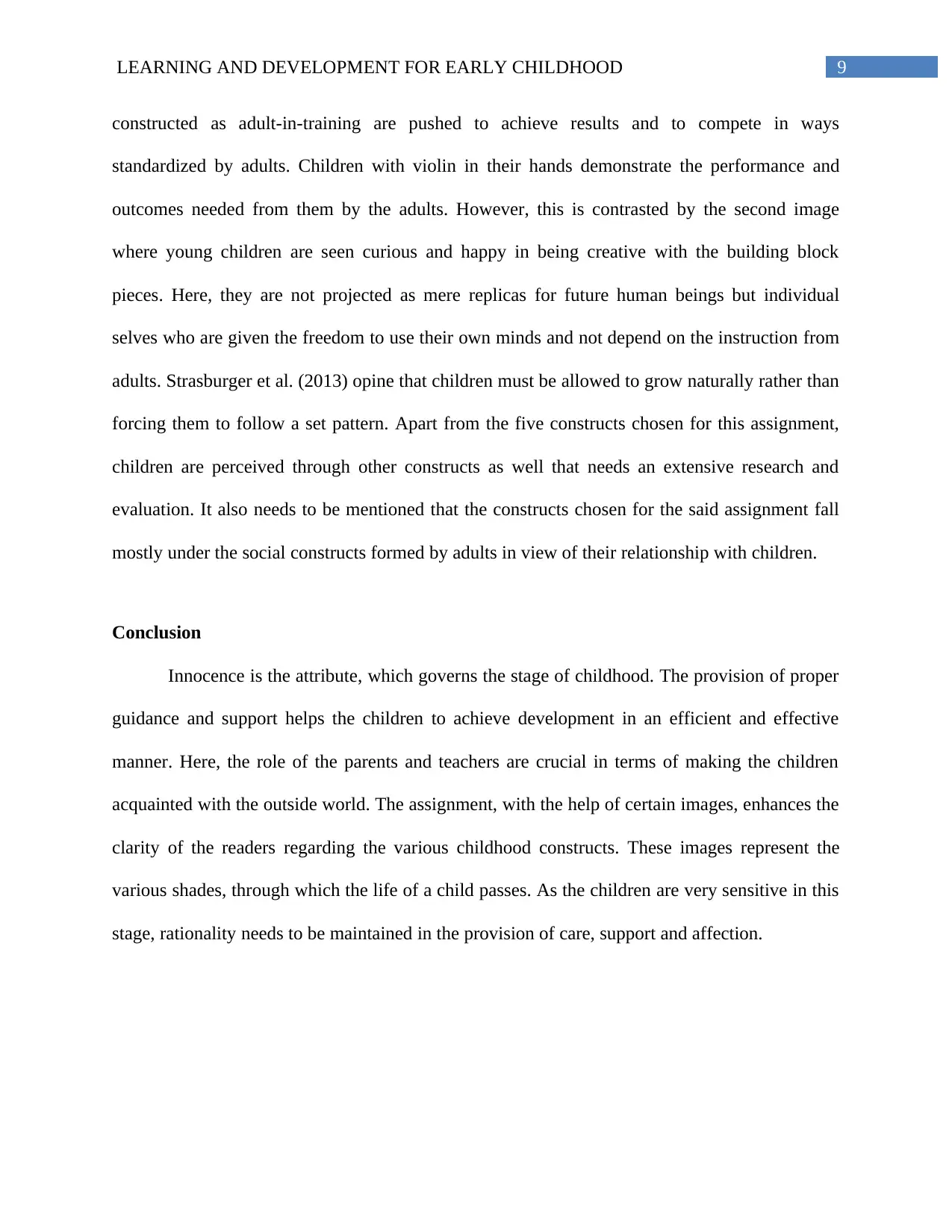
9LEARNING AND DEVELOPMENT FOR EARLY CHILDHOOD
constructed as adult-in-training are pushed to achieve results and to compete in ways
standardized by adults. Children with violin in their hands demonstrate the performance and
outcomes needed from them by the adults. However, this is contrasted by the second image
where young children are seen curious and happy in being creative with the building block
pieces. Here, they are not projected as mere replicas for future human beings but individual
selves who are given the freedom to use their own minds and not depend on the instruction from
adults. Strasburger et al. (2013) opine that children must be allowed to grow naturally rather than
forcing them to follow a set pattern. Apart from the five constructs chosen for this assignment,
children are perceived through other constructs as well that needs an extensive research and
evaluation. It also needs to be mentioned that the constructs chosen for the said assignment fall
mostly under the social constructs formed by adults in view of their relationship with children.
Conclusion
Innocence is the attribute, which governs the stage of childhood. The provision of proper
guidance and support helps the children to achieve development in an efficient and effective
manner. Here, the role of the parents and teachers are crucial in terms of making the children
acquainted with the outside world. The assignment, with the help of certain images, enhances the
clarity of the readers regarding the various childhood constructs. These images represent the
various shades, through which the life of a child passes. As the children are very sensitive in this
stage, rationality needs to be maintained in the provision of care, support and affection.
constructed as adult-in-training are pushed to achieve results and to compete in ways
standardized by adults. Children with violin in their hands demonstrate the performance and
outcomes needed from them by the adults. However, this is contrasted by the second image
where young children are seen curious and happy in being creative with the building block
pieces. Here, they are not projected as mere replicas for future human beings but individual
selves who are given the freedom to use their own minds and not depend on the instruction from
adults. Strasburger et al. (2013) opine that children must be allowed to grow naturally rather than
forcing them to follow a set pattern. Apart from the five constructs chosen for this assignment,
children are perceived through other constructs as well that needs an extensive research and
evaluation. It also needs to be mentioned that the constructs chosen for the said assignment fall
mostly under the social constructs formed by adults in view of their relationship with children.
Conclusion
Innocence is the attribute, which governs the stage of childhood. The provision of proper
guidance and support helps the children to achieve development in an efficient and effective
manner. Here, the role of the parents and teachers are crucial in terms of making the children
acquainted with the outside world. The assignment, with the help of certain images, enhances the
clarity of the readers regarding the various childhood constructs. These images represent the
various shades, through which the life of a child passes. As the children are very sensitive in this
stage, rationality needs to be maintained in the provision of care, support and affection.
Paraphrase This Document
Need a fresh take? Get an instant paraphrase of this document with our AI Paraphraser
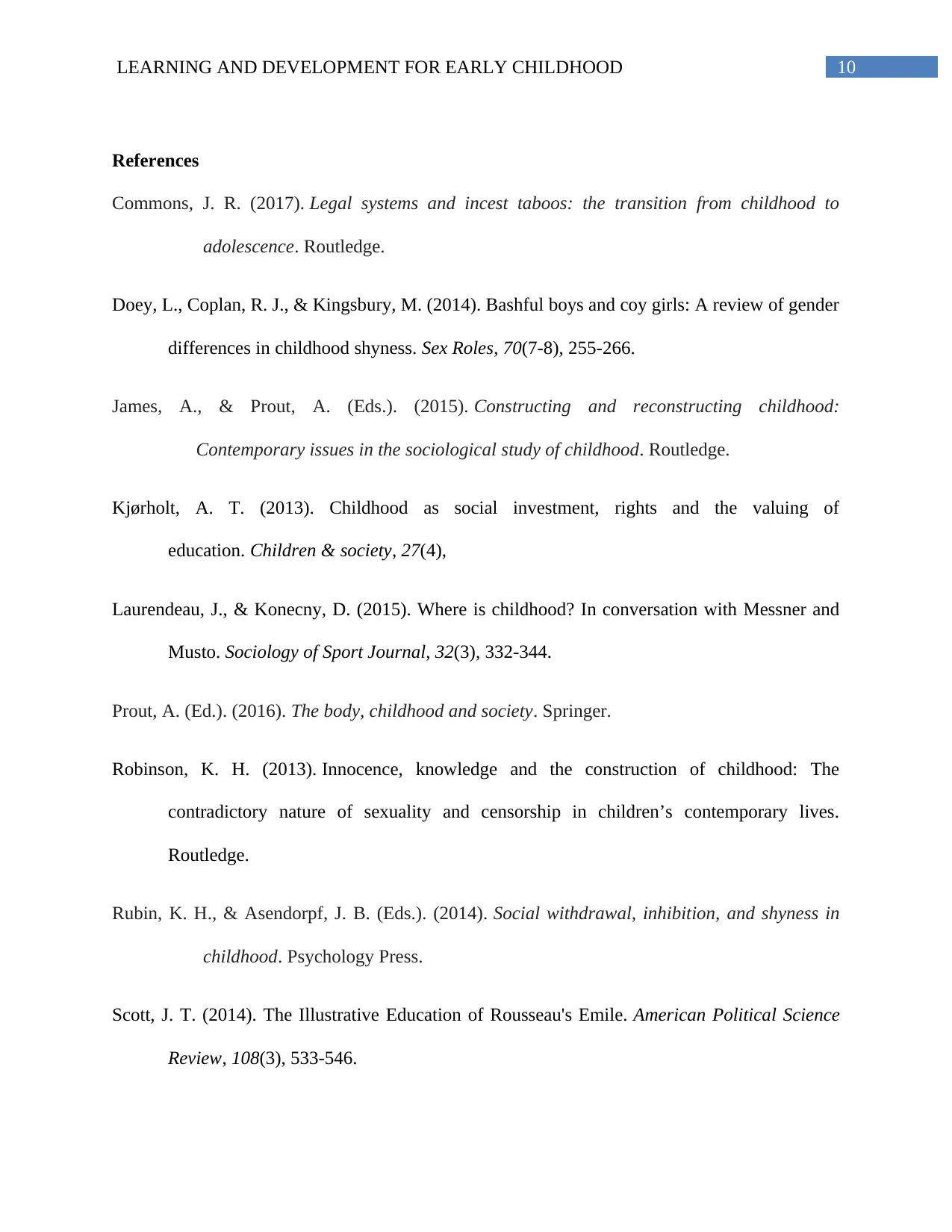
10LEARNING AND DEVELOPMENT FOR EARLY CHILDHOOD
References
Commons, J. R. (2017). Legal systems and incest taboos: the transition from childhood to
adolescence. Routledge.
Doey, L., Coplan, R. J., & Kingsbury, M. (2014). Bashful boys and coy girls: A review of gender
differences in childhood shyness. Sex Roles, 70(7-8), 255-266.
James, A., & Prout, A. (Eds.). (2015). Constructing and reconstructing childhood:
Contemporary issues in the sociological study of childhood. Routledge.
Kjørholt, A. T. (2013). Childhood as social investment, rights and the valuing of
education. Children & society, 27(4),
Laurendeau, J., & Konecny, D. (2015). Where is childhood? In conversation with Messner and
Musto. Sociology of Sport Journal, 32(3), 332-344.
Prout, A. (Ed.). (2016). The body, childhood and society. Springer.
Robinson, K. H. (2013). Innocence, knowledge and the construction of childhood: The
contradictory nature of sexuality and censorship in children’s contemporary lives.
Routledge.
Rubin, K. H., & Asendorpf, J. B. (Eds.). (2014). Social withdrawal, inhibition, and shyness in
childhood. Psychology Press.
Scott, J. T. (2014). The Illustrative Education of Rousseau's Emile. American Political Science
Review, 108(3), 533-546.
References
Commons, J. R. (2017). Legal systems and incest taboos: the transition from childhood to
adolescence. Routledge.
Doey, L., Coplan, R. J., & Kingsbury, M. (2014). Bashful boys and coy girls: A review of gender
differences in childhood shyness. Sex Roles, 70(7-8), 255-266.
James, A., & Prout, A. (Eds.). (2015). Constructing and reconstructing childhood:
Contemporary issues in the sociological study of childhood. Routledge.
Kjørholt, A. T. (2013). Childhood as social investment, rights and the valuing of
education. Children & society, 27(4),
Laurendeau, J., & Konecny, D. (2015). Where is childhood? In conversation with Messner and
Musto. Sociology of Sport Journal, 32(3), 332-344.
Prout, A. (Ed.). (2016). The body, childhood and society. Springer.
Robinson, K. H. (2013). Innocence, knowledge and the construction of childhood: The
contradictory nature of sexuality and censorship in children’s contemporary lives.
Routledge.
Rubin, K. H., & Asendorpf, J. B. (Eds.). (2014). Social withdrawal, inhibition, and shyness in
childhood. Psychology Press.
Scott, J. T. (2014). The Illustrative Education of Rousseau's Emile. American Political Science
Review, 108(3), 533-546.
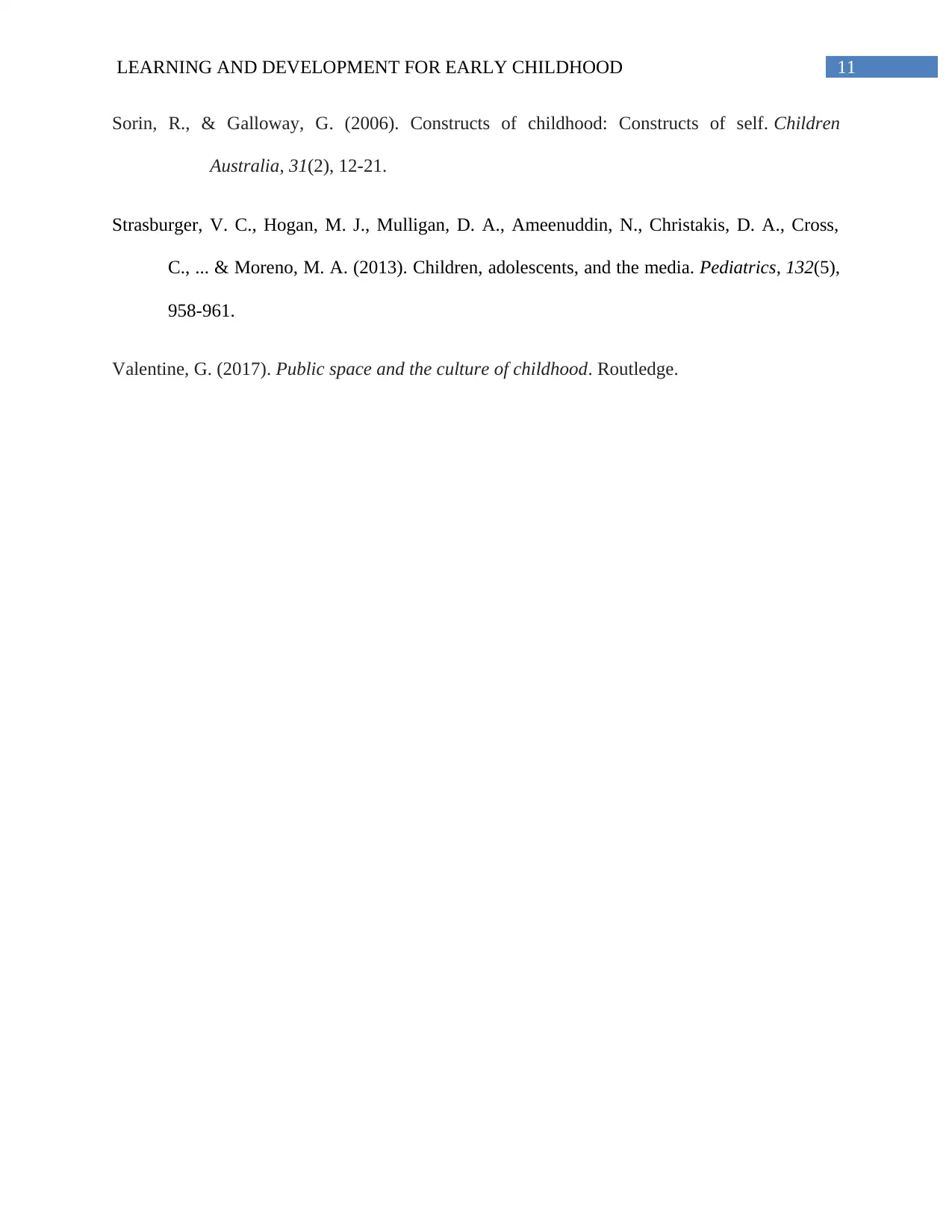
11LEARNING AND DEVELOPMENT FOR EARLY CHILDHOOD
Sorin, R., & Galloway, G. (2006). Constructs of childhood: Constructs of self. Children
Australia, 31(2), 12-21.
Strasburger, V. C., Hogan, M. J., Mulligan, D. A., Ameenuddin, N., Christakis, D. A., Cross,
C., ... & Moreno, M. A. (2013). Children, adolescents, and the media. Pediatrics, 132(5),
958-961.
Valentine, G. (2017). Public space and the culture of childhood. Routledge.
Sorin, R., & Galloway, G. (2006). Constructs of childhood: Constructs of self. Children
Australia, 31(2), 12-21.
Strasburger, V. C., Hogan, M. J., Mulligan, D. A., Ameenuddin, N., Christakis, D. A., Cross,
C., ... & Moreno, M. A. (2013). Children, adolescents, and the media. Pediatrics, 132(5),
958-961.
Valentine, G. (2017). Public space and the culture of childhood. Routledge.
⊘ This is a preview!⊘
Do you want full access?
Subscribe today to unlock all pages.

Trusted by 1+ million students worldwide
1 out of 12
Your All-in-One AI-Powered Toolkit for Academic Success.
+13062052269
info@desklib.com
Available 24*7 on WhatsApp / Email
![[object Object]](/_next/static/media/star-bottom.7253800d.svg)
Unlock your academic potential
Copyright © 2020–2025 A2Z Services. All Rights Reserved. Developed and managed by ZUCOL.

